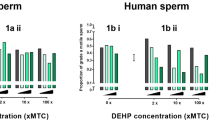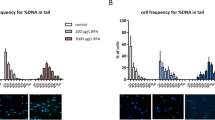Abstract
Introduction and aims
The Chilean Altiplano ecosystem is conserved free from contaminants and pollutants because of the absence of major local human activities such as agriculture or other industries. We studied the effects of paraoxon on proliferation and apoptosis of testicular cells during active spermatogenesis in Dugesia gonocephala collected from a pristine river (Guacollo) in the Altiplano region nearby Visviri town, Chile.
Materials and methods
Adult planarians were incubated in varying concentrations of paraoxon (0.8, 0.4, 0.04, 0.004, and 0.0004 mM) for 4 h. After 3 h of incubation, bromodeoxyuridine (BrdU) was added. Effects on cell proliferation (BrdU) and apoptosis (Apaf-1) were determined by immunohistochemistry.
Results
Paraoxon concentrations of 0.4 and 0.8 mM caused 100% mortality in the respective treatment groups. The lowest tested concentration (0.0004 mM) caused a significant increase on cell proliferation in the seminiferous tubules, as well as an increase in the number of apoptotic cells. All other tested concentrations significantly inhibited cell proliferation and induced apoptosis.
Conclusions
Paraoxon inhibits DNA synthesis and induces apoptosis during spermatogenesis in adult planarians from a high-altitude, pollution-free environment. This could suggest its use as a biosensor or biomarker for contamination with agro pesticides.

Similar content being viewed by others
References
Amaya-Chavez A, Lopez-Lopez E, Galar-Martinez M, Gomez-Olivan L, Garcia-Fabila M (2009) Removal of methyl parathion in water, by Dugesia dorotocephala. Bull Environ Contam Toxicol 83:334–336
ATSDR, Agency for Toxic Substances and Disease Register (2001) Toxicological profile for methyl parathion, update. Department of Health and Human Services, Public Health Service, Atlanta
Baguna J, Romero R (1981) Quantitative analysis of cell types during growth, degrowth and regeneration in the planarians Dugesia mediterranea and Dugesia tigrina. Hydrobiologia 84:181–194
Baguna J (1981) Planarian neoblasts. Nature 290:14–15
Best J, Morita M (1982) Planarians as a model system for in vitro teratogenesis studies. Teratog Carcinog Mut 2:277–291
Cabello G, Valenzuela M, Vilaxa A, Duran V, Rudolph I, Hrepic N, Calaf G (2001) A rat mammary tumor model induced by the organophosphorous pesticides parathion and malathion, possibly through acetylcholinesterase inhibition. Environ Health Perspect 109:471–479
Carlson K, Jortner B, Ehrich M (2000) Organophosphorus compound-induced apoptosis in SH-SY5Y human neuroblastoma cells. Toxicol Appl Pharmacol 168:102–113
Espinoza-Navarro O, Bustos-Obregon E (2004) Sublethal doses of malathion alter male reproductive parameters of Eisenia foetida. Int J Morphol 22:297–302
Espinoza-Navarro O, Bustos-Obregon E (2005) Effect of malathion on the male reproductive organs of earthworms, Eisenia foetida. Asian J Androl 7:97–101
Favari L, Lopez E, Martinez-Tabche L, Diaz-Pardo E (2002) Effect of insecticides on plankton and fish of Ignacio Ramirez Reservoir (Mexico). A biochemical and biomagnification study. Ecotoxicol Environ Saf 51:177–186
Horvat T, Kalafatic M, Kopjar N, Kovacevi G (2005) Toxicity testing of herbicide norflurazon on an aquatic bioindicator species—the planarian Polycelis felina (Daly.). Aquatic Toxicol 73:342–352
Hwang J, Kobayashi C, Agatab K, Ikeo K, Gojobori T (2004) Detection of apoptosis during planarian regeneration by the expression of apoptosis-related genes and TUNEL assay. Gene 333:15–25
Kim Y, Lee H, Park Y, lee Y (2000) A convenient method for oxidation of organophosphorus pesticides in organic solvents. Environ Res 84:303–309
Lau A, Knakievicz T, Pra D, Erdtmann B (2007) Freshwater planarians as novel organisms for genotoxicity testing: analysis of chromosome aberrations. Environ Mol Mutag 48:475–482
Li Q, Nagahara N, Takahashi H, Takeda K, Okumura K, Minami M (2002) Organophosphorus pesticides markedly inhibit the activities of natural killer, cytotoxi T lymphocyte and lymphokine-activated killer: a proposed inhibiting mechanism via granzyme inhibition. Toxicology 172:181–190
Malhao V, Raposeiro P, Costa A (2007) The Family Dugesiidae: new records for the Azorean Archipelago. Limnetica 26(2):331–340
Molofsky A, Pardal R, Morrison S (2004) Diverse mechanisms regulate stem cell self-renewal. Curr Opin Cell Biol 16:700–707
Moraczewski J, Archack K, Brzoska E, Ciemerych M, Grabowska L, Janczyk-ilach K, Streminska W, Zimowska M (2008) From planarians to mammals—the many faces of regeneration. Int J Dev Biol 52:219–227
Newmark P, Sanchez A (2000) Bromodeoxyuridine specifically labels the regenerative stem cells of planarians. Dev Biol 220:142–153
Nano G, Binello A, Bianco M, Ugazio G, Burdino S (2002) In vitro tests to evaluate potential biological activity in natural substances. Fitoterapia 73:140–146
Pellettieri J, Sanchez A (2007) Cell turnover and adult tissue homeostasis: from humans to planarians. Ann Rev Genet 41:83–105
Pfister D, De Mulder K, Philipp I, Kuales G, Hrouda M, Eichberger P, Borgonie G, Hartenstein V, Ladurner P (2007) The exceptional stem cell system of Macrostomum lignano: screening for gene expression and studying cell proliferation by hydroxyurea treatment and irradiation. Front Zool 4:9
Reddien P, Bermange A, Murfitt K, Jennings J, Sanchez A (2005) Identification of genes needed for regeneration, stem cell function, and tissue homeostasis by systematic gene perturbation in planaria. Dev Cell 8:635–649
Robb S, Sanchez A (2002) Identification of immunological reagents for use in the study of freshwater planarians by means of whole-mount immunofluorescence and confocal microscopy. Genesis 32:293–298
Rodriguez H, Walker K, Guzman M, Bustos-Obregon E (2001) Parathion effects on RNA synthesis in human spermatogenesis. J Androl 364:321–325
Rodriguez H, Bustos-Obregon E (2000) An in vitro model to evaluate the effect of an organophosphoric agropesticide on cell proliferation in mouse seminiferous tubules. Andrologia 32:1–5
Rodriguez H, Guzman M, Galanti A (2005) Concentraciones plasmáticas de FSH y morfometría testicular bajo los efectos de un análogo del GnRH: la Buserelina. Rev Int Androl 3:6–9
Rodriguez H, Guzman M, Espinoza O (2006) Parathion effects on protein synthesis in the seminiferous tubules of mice. Ecotoxicol Environ Saf 65:129–133
Salo E, Baguna J (1984) Regeneration and pattern formation in planarians: I. The pattern of mitosis in anterior and posterior regeneration in Dugesia (G) tigrina, and a new proposal for blastema formation. J Embryol Exp Morphol 83:63–80
Salo E, Baguna J (1985) Stimulation of cellular proliferation and differentiation in the intac and regenerating planaria Dugesia (G) tigrina by the neuropeptide substance P. J Exp Zool 237:129–135
Salo E, Baguna J (2002) Regeneration in planarians and the others worms: new findings, new tools and new perspectives. J Exp Zool 292:528–539
Sanchez A (2000) Regeneration in the metazoans: why does it happen? BioEssay 22:578–590
Sanchez A, Newmark P (1998) The use of planarians to dissect the molecular basis of metazoan regeneration. Wound Repair Regen 6:413–420
Sommer L, Rao M (2002) Neural stem cells and regulation of cell number. Prog Neurobiol 66:1–18
Surendra B, Surendra R (1999) Toxic impact of organophosphorus insecticides on acetylcholinesterase activity in the silkworm, Bombyx mori L. Ecotoxicol Environ Saf 42:157–162
Villar D, Gonzalez M, Gualda M, Schaeffer D (1994) Effects of organophosphorus insecticides on Dugesia tigrina: cholinesterase activity and head regeneration. Bull Environ Contain Toxicol 52:319–324
Acknowledgments
The present work was partially funded by the Universidad de Tarapacá, research project no. 4792 and FONDECYT 1101046- 2010. We also appreciate the cooperation of the technical assistant, Mr. Juan Borja.
Disclosure statement
We would like to express our manifest authorization for the publication and diffusion of this research paper and declare that we do not have any conflict of interest.
Author information
Authors and Affiliations
Corresponding author
Additional information
Responsible editor: Markus Hecker
Rights and permissions
About this article
Cite this article
Rodríguez, H.H., Espinoza-Navarro, O., Silva, I. et al. The effect of paraoxon on spermatogenesis in Dugesia gonocephala from the Chilean Altiplano: proliferation and apoptosis. Environ Sci Pollut Res 18, 497–502 (2011). https://doi.org/10.1007/s11356-010-0385-0
Received:
Accepted:
Published:
Issue Date:
DOI: https://doi.org/10.1007/s11356-010-0385-0




